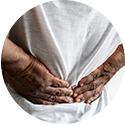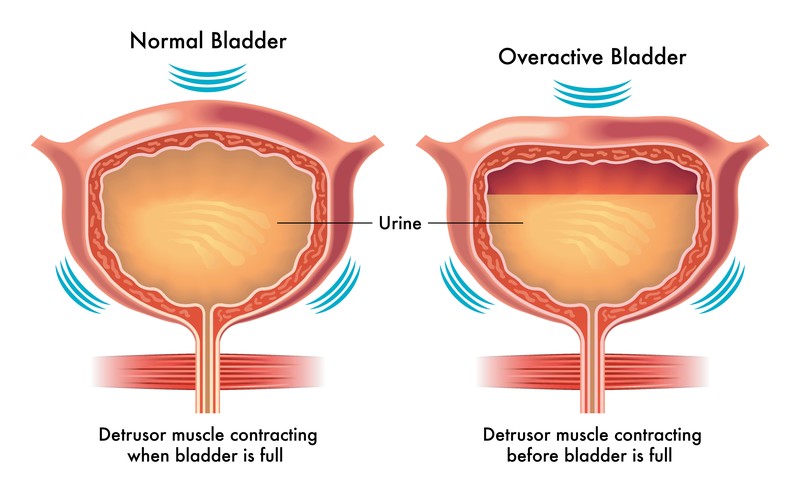In many patients we see, overactive bladder is not the primary complaint of their health concerns. It is a problem within many problems and in many cases a symptom of a greater problem. That problem is metabolic syndrome. Metabolic syndrome is a constellation of developing health problems that include type 2 diabetes, high blood pressure, high cholesterol, and being overweight and obese. It is often suggested to doctors that in their initial consultation with a patient, that a large waist line or big belly should be a clear indication that Metabolic Syndrome is present in this patient.
We see many patients with secondary urinary problems Some of urinary incontinence. This is a dripping or leakage problem that many of you may already be very familiar with because you have it. Overactive bladder is different. This is generally a problem of the need to frequently urinate and the need comes on suddenly. There is no time to “hold it in.”
A great lack of information in the medical literature on the association between bladder problems and metabolic syndrome
A recent study from the United Kingdom published in the International journal of clinical practice (1) discusses the relationship between the problems of overactive bladder and the constellation of challenges associated with a diagnosis of metabolic syndrome.
Women not getting good information from doctors on overactive bladder
Here the researchers of this study noted that there is a great lack of information in the medical literature on the impact of metabolic syndrome on problems of overactive bladder especially in women. The research information that is available to doctors to help these women is usually of low quality, however, a doctor looking deep into the research can find evidence that obesity and other components of metabolic syndrome causes and can predict urinary problems.
Women over 60 who are not active have more urgent urinary incontinence
A study from February 2020 (2) points out the obvious, urinary incontinence is associated with age related problems of physical and cognitive impairments. But, urinary incontinence is made worse by sedentary behavior. What the study discovered was the longer the length of sedentary behavior the greater the urgent urinary incontinence. The simple solution? The best targeted intervention to treat this was to get the women more active.
Many of the women with urinary problems will be overweight and will have features of the metabolic syndrome, if looked for.
The conclusion of this research makes a strong point: Many of the women with urinary problems will be overweight and will have features of the metabolic syndrome, if looked for. Emphasis on “IF LOOKED FOR.” Looking for and finding this connection provides not only an opportunity to encourage weight loss as an adjunct to therapy for overactive bladder symptoms but also a window of opportunity to address cardiovascular risk factors and prevent future cardiovascular morbidity and mortality.
This research supports an earlier study published in the French language journal Progrès en urologie : journal de (The Journal of progress in urology)(3). Here researchers confirmed previous studies suggesting that patients with Metabolic syndrome suffered from overactive bladder symptoms and urinary incontinence and these problems were brought on by abdominal obesity and hyperglycemia.
A January 2019 study in the journal Urology (4) cited this research in determining that central and general obesity were key metabolic factors associated with urinary tract infections in both males and females, and with overactive bladder symptoms in females.
Insulin resistance, especially in women, may play significant role in the development of overactive bladder
When a patient comes into our office with general complaints of fatigue, “being sick all the time,” and just not feeling well, and we see a big belly, there is a clue that insulin resistance maybe a contributing factor to their problems with metabolic syndrome.
Simply, insulin is our hormone that processes glucose from the foods we eat to generate fuel to provide energy. After we eat the pancreas produces and releases more insulin into the blood stream to pick up and process this glucose. Insulin resistance occurs when this process is broken and glucose cannot be absorbed by the body. How does the process break? In most general terms, you have too much glucose in the blood. This comes from over eating and poor dietary choices. When there is too much gluocose in the blood, the pancreas has to produce more insulin. The pancreas can produce so much insulin that the cells of the body become resistant to its demand to absorb more glucose than they need.The cells have become resistant to insulin’s demands. This is the path to type 2 diabetes and elevated blood sugars.
In a study published in the International neurourology journal (5) researchers confirmed that metabolic syndrome and obesity are risk factors for the development of overactive bladder because and in part of insulin resistance.
Men with waists measuring 39+ inches reported up to three times more urinary problems than men with waists of 39 inches or less.
Belly fat is a national plague. The myriad of health problems associated with belly fat are so numerous that to mention them all would require you to read a very long list of the obvious. Here is one less well known – the problems of frequent urination.
In a recent published study, men with large waists urinate more frequently than their slimmer counterparts.
Larger waist circumference was also associated with urinating more than twice during the night
Researchers from Weill Medical College, Cornell University, New York, (6) found that:
Men with waists measuring 39+ inches reported up to three times more urinary problems than men with waists of 39 inches or less.
Larger waist circumference was also associated with urinating more than twice during the night – with 44% of men in the largest waist group reporting this, compared with 29% in the middle group and 15% in the smallest waist group.
Men with larger waists were also more likely to report erection problems
Men with larger waists were also more likely to report erection problems than men in the middle and smallest waist groups (74.5%, 50% and 32% respectively) and more likely to report ejaculation problems (65%, 40% and 21% respectively.)
Men in the largest waist group had a 39% higher odds risk of prostate volume problems than men in the smallest waist group
The same pattern was observed for high blood pressure (33.5%, 22% and 14.5% respectively), coronary artery disease (29%, 17% and 8%), type 2 diabetes (33%, 16% and 11%) and cholesterol (254mg/dL, 176 mg/dL and 148 mg/dL).
The researchers also analyzed the relationship between waist size and the odds risk of greater problems from various urological, sexual, metabolic and cardiovascular problems. This showed that:
Men in the largest waist group had a 39% higher odds risk of prostate volume problems than men in the smallest waist group. The odds risk of higher prostate-specific antigen levels was 111% greater and the odds risk of a higher International Prostate Symptom Score was 68%.
The odds risk of erection problems was 132% higher and it was 202% higher for ejaculation problems. High blood pressure, type 2 diabetes and coronary artery disease were 131%, 188% and 250% higher. Therefore represent an easy diagnostic tool when it comes to the likelihood of male urinary problems.” (6,7)
Researchers also noted a prostate connection. In the journal Medicine (8) they wrote of the connection between obesity and metabolic syndrome and prostate disease making an association between metabolic syndrome and benign prostatic hyperplasia (BPH) including prostate growth rate, prostate volume, International Prostate Symptom Score, prostate-specific antigen (PSA) level, and maximal flow rate.
If you would like to explore more information, please contact our office so we can start a conversation with you.
Related articles:
Older Men and Women Not Getting Good Information From Doctors on Overactive Bladder
References
1 Tubaro A, Wagg A. Is there a link between overactive bladder and the metabolic syndrome in women? A systematic review of observational studies. Int J Clin Pract. 2015 Feb;69(2):199-217. doi: 10.1111/ijcp.12518. Epub 2014 Dec 11
2 Jerez-Roig J, Booth J, Skelton DA, Giné-Garriga M, Chastin SF, Hagen S. Is urinary incontinence associated with sedentary behaviour in older women? Analysis of data from the National Health and Nutrition Examination Survey. Plos one. 2020 Feb 4;15(2):e0227195.
3 Boudokhane S, Marmouche H, Klii R, Jellad A, Mahjoub S, Ben Salah Frih Z. Urinary disorders and metabolic syndrome: prospective study Prog Urol. 2013 Apr;23(4):256-61.
4 Lai HH, Helmuth ME, Smith AR, Wiseman JB, Gillespie BW, Kirkali Z. Relationship Between Central Obesity, General Obesity, Overactive Bladder Syndrome and Urinary Incontinence Among Male and Female Patients Seeking Care for Their Lower Urinary Tract Symptoms. Urology. 2019 Jan 1;123:34-43.
5 Uzun H, Yilmaz A, Kemik A, Zorba OU, Kalkan M. Association of insulin resistance with overactive bladder in female patients. Int Neurourol J. 2012 Dec;16(4):181-6. doi: 10.5213/inj.2012.16.4.181. Epub 2012 Dec 31.
6 https://www.wiley.com/WileyCDA/PressRelease/pressReleaseId-104359.html
7 Lee RK, Chung D, Chughtai B, et al. Central obesity as measured by waist circumference is predictive of severity of lower urinary tract symptoms. BJU International, 2012; 110 (4): 540 DOI: 10.1111/j.1464-410X.2011.10819.x
8 Wang JY, Fu YY, Kang DY. The association between metabolic syndrome and characteristics of benign prostatic hyperplasia: a systematic review and meta-analysis. Medicine. 2016 May;95(19).





































Recent Comments